To enjoy the benefits of connected security, businesses need security technologies which work seamlessly with each other. In a recent survey of industry professionals, over 90% noted the critical importance of integration across building management functions.
But why is integration judged to be so important? What exactly are its benefits? And how can an organisation reap them?
In fact, there are several ways a connected access solution can help a business to do more — both enhancing security and contributing to overall business success.
1. Control every system from a single seat
“Access control systems are often viewed as the starting point for a building to shift from operating in siloes, towards a more functional, connected and ‘integrated’ building management system,” explains a new IFSEC Global white paper on security management. The white paper considers integration’s cost and efficiency impact on organizations.
Control from a single, integrated interface boosts efficiency in many ways. Some are individual to the industry or business, but there are advantages which apply almost anywhere. Firstly, integration reduces training needs and therefore costs: everything is administered from a single system, rather than several working in isolation.
Secondly, when facilities staff only consult or update one interface, they save time and reduce manual errors.
In a real-world situation, integration can even save facility managers’ journey time. At the InHolland University of Applied Sciences, for example, a Nedap AEOS system integrated with Aperio wireless devices controls access for seven different campuses from a single, integrated point.
Thirdly, analytics can deliver more value and better insights when multiple sources of data provide input.
2. Future-proof a system with standards-compliant hardware
Connected access control helps businesses to retool building management for the challenges of the 2020s. The smart building is integrated and automated, relying on standards for interoperability to keep data flowing in every direction.
OSDP, for example, streamlines the interoperability of access control and security devices. ONVIF Profile D & Profile M help access control devices connect with analytics.
Access control hardware which is designed for interoperability — with accessible APIs and SDKs for app integration — creates security which is ready for what’s next, even when predicting “what’s next” can be difficult.
3. Attract and retain staff with flexible working
In a survey conducted by consultants McKinsey & Company, 63% of employees said they would prefer a “hybrid” or fully remote work schedule. To offer this kind of flexibility cost-effectively, security provision must be able to adapt. Smarter use of space is ever more important as employees come to favour hybrid work patterns.
To assist in a move to hybrid working, access control credentials can be authorised to unlock doors during specific timeframes, so staff enter only when scheduled, for example. Facility managers can regulate daily access so building occupancy stays within capacity.
A single hub — for issuing, amending and revoking access rights — streamlines the administration of a hybrid system. Trying to implement such a change via multiple electronic and/or mechanical access systems in parallel could create an enormous workload. Integrated electronic access control makes it easy.
A new white paper — “Boosting efficiency and streamlining security with an integrated access control solution” — provides essential background for all key decision-makers who are considering an integration project. Download a free copy here.
For more news updates, check out our May issue here.
Media contact
Rebecca Morpeth Spayne,
Editor, Security Portfolio
Tel: +44 (0) 1622 823 922



























